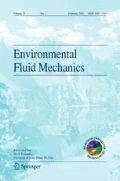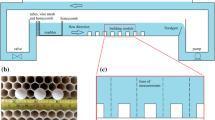Abstract
For over 100 years, laboratory-scale von Kármán vortex streets (VKVSs) have been one of the most studied phenomena within the field of fluid dynamics. During this period, countless publications have highlighted a number of interesting underpinnings of VKVSs; nevertheless, a universal equation for the vortex shedding frequency (\(N\)) has yet to be identified. In this study, we have investigated \(N\) for mesoscale atmospheric VKVSs and some of its dependencies through the use of realistic numerical simulations. We find that vortex shedding frequency associated with mountainous islands, generally demonstrates an inverse relationship to cross-stream obstacle length (\(L\)) at the thermal inversion height of the atmospheric boundary layer. As a secondary motive, we attempt to quantify the relationship between \(N\) and \(L\) for atmospheric VKVSs in the context of the popular Strouhal number (\(Sr\))–Reynolds number (\(Re\)) similarity theory developed through laboratory experimentation. By employing numerical simulation to document the \(Sr{-}Re\) relationship of mesoscale atmospheric VKVSs (i.e., in the extremely high \(Re\) regime) we present insight into an extended regime of the similarity theory which has been neglected in the past. In essence, we observe mesoscale VKVSs demonstrating a consistent \(Sr\) range of 0.15–0.22 while varying \(L\) (i.e, effectively varying \(Re\)).











Similar content being viewed by others
Notes
We arrive at these values for \(Re\) based on magnitudinal analysis assuming \(\nu \approx 10^{-5}\) m\(^2\) s\(^{-1}\), \(\mathrm{O }\bigl (1\bigr ) <V<\mathrm{O }\bigl (10\bigr )\) m s\(^{-1}\), and \(\mathrm{O }\bigl (1\bigr ) <L< \mathrm{O }\bigl (100\bigr )\) km.
References
Achenbach E, Heinecke E (1981) On vortex shedding from smooth and rough cylinders in the range of Reynolds numbers \(6~\times ~10^3\) to \(5~\times ~10^6\). J Fluid Mech 109(1):239–251
Aebischer U, Schär C (1998) Low-level potential vorticity and cyclogenesis to the lee of the Alps. J Atmos Sci 55(2):186–207
Bénard H (1908) Étude cinématographique des remous et des rides produits par la translation dun obstacle. Compt Rend Acad Sci 147:970–972
Berlin P (1981) Meteosat tracks Karman vortex streets in the atmosphere. ESA Bull 1:16–19
Berrisford P, Dee D, Fielding K, Fuentes M, Kllberg P, Kobayashi S, Uppala S (2009) The ERA-Interim archive. Tech. rep., ECMWF. ERA Report Series, No.1
Birkhoff G, Zarantonello E (1957) Jets, wakes, and cavities, vol 2. Academic Press, New York
Caldeira RM, Tomé R (2013) Wake response to an ocean-feedback mechanism: Madeira island case study. Bound Layer Meteorol 5:1–18. doi:10.1007/s10546-013-9817-y
Chen F, Dudhia J (2001) Coupling an advanced land-surface/hydrology model with the Penn State/NCAR MM5 modeling system. Mon Weather Rev 129:587–604
Chopra K, Hubert L (1965) Mesoscale eddies in wake of islands. J Atmos Sci 22(6):652–657
Couvelard X, Caldeira R, Araujo I, Tomé R (2012) Wind mediated vorticity-generation and eddy-confinement, leeward of the Madeira island: 2008 numerical case study. Dyn Atmos Oceans 58:128–149
Dudhia J (1989) Numerical study of convection observed during the winter monsoon experiment using a mesoscale two-dimensional model. J Atmos Sci 46:3077–3107
Epifanio C, Durran D (2002) Lee-vortex formation in free-slip stratified flow over ridges. part I: comparison of weakly nonlinear inviscid theory and fully nonlinear viscous simulations. J Atmos Sci 59(7):1153–1165
Epifanio C, Durran D (2002) Lee-vortex formation in free-slip stratified flow over ridges. part II: mechanisms of vorticity and PV production in nonlinear viscous wakes. J Atmos Sci 59(7):1166–1181
Etling D (1989) On atmospheric vortex streets in the wake of large islands. Meteorol Atmos Phys 41(3):157–164
Global forecast system documentation version 9.0.1. http://www.emc.ncep.noaa.gov/GFS/doc.php. Accessed: 04/03/2012 from the National Centers for Environmental Prediction
Heinze R, Raasch S, Etling D (2012) The structure of Kármán vortex streets in the atmospheric boundary layer derived from large eddy simulation. Meteorol Z 21(3):221–237
Hollingshead AT, Businger S, Draxler R, Porter J, Stevens D (2003) Dispersion modelling of the Kilauea plume. Bound Layer Meteorol 108(1):121–144
Hong SY, Dudhia J, Chen SH (2004) A revised approach to ice microphysical processes for the bulk parameterization of clouds and precipitation. Mon Weather Rev 132:103–120
Horváth Á (2013) Improvements to MISR stereo motion vectors. J Geophys Res 118:5600–5620
Hubert L, Krueger A (1962) Satellite pictures of mesoscale eddies. Mon Weather Rev 90(11):457–463
Hunt JCR, Simpson JE (1982) Atmospheric boundary layers over non-homogeneous terrain. Elsevier, Amsterdam, pp 269–318
Janjic̀ ZI (1994) The step-mountain eta coordinate model: further developments of the convection, viscous sublayer, and turbulence closure schemes. Mon Weather Rev 122:927–945
Kain J (2004) The Kain-Fritsch convective parameterization: an update. J Appl Meteorol 43:170–181
King M, Menzel W, Kaufman Y, Tanré D, Gao B, Platnick S, Ackerman S, Remer L, Pincus R, Hubanks P (2003) Cloud and aerosol properties, precipitable water, and profiles of temperature and water vapor from MODIS. IEEE Trans Geosci Remote Sens 41(2):442–458
King M, Platnick S, Yang P, Arnold G, Gray M, Riedi J, Ackerman S, Liou K (2004) Remote sensing of liquid water and ice cloud optical thickness and effective radius in the arctic: application of airborne multispectral MAS data. J Atmos Ocean Technol 21(6):857–875
Li X, Zheng W, Zou C, Pichel W (2008) A SAR observation and numerical study on ocean surface imprints of atmospheric vortex streets. Sensors 8(5):3321–3334
Lindborg E (1999) Can the atmospheric kinetic energy spectrum be explained by two-dimensional turbulence? J Fluid Mech 388:259–288
Mallock A (1907) On the resistance of air. Proc R Soc Lond 79(530):262–273
Matsumoto M, Daito Y, Kanamura T, Shigemura Y, Sakuma S, Ishizaki H (1998) Wind-induced vibration of cables of cable-stayed bridges. J Wind Eng Ind Aerodyn 74:1015–1027
Mlawer E, Taubman S, Brown P, Lacono M (1997) Radiative transfer for inhomogeneous atmosphere: RRTM, a validated correlated-k model for the longwave. J Geophys Res 102:16663–16682
Nappo CJ (2012) An introduction to atmospheric gravity waves, vol 102. Academic Press, New York
NASA (2013) Moderate resolution imaging spectroradiometer image gallery. http://modis.gsfc.nasa.gov/gallery/#
Platnick S, King M, Ackerman S, Menzel W, Baum B, Riédi J, Frey R (2003) The MODIS cloud products: algorithms and examples from Terra. IEEE Trans Geosci Remote Sens 41(2):459–473
Ponta FL, Aref H (2004) Strouhal-Reynolds number relationship for vortex streets. Phys Rev Lett 93(8):84501
Roshko A (1954) On the development of turbulent wakes from vortex streets. Tech. rep, National Advisory Committee for Aeronautics
Rotunno R, Grubišic V, Smolarkiewicz P (1999) Vorticity and potential vorticity in mountain wakes. J Atmos Sci 56(16):2796–2810
Roushan P, Wu X (2005) Universal wake structures of Kármán vortex streets in two-dimensional flows. Phys Fluids 17:073601
Schär C, Durran DR (1997) Vortex formation and vortex shedding in continuously stratified flows past isolated topography. J Atmos Sci 54(4):534–554
Schär C, Smith RB (1993) Shallow-water flow past isolated topography. part I: vorticity production and wake formation. J Atmos Sci 50(10):1373–1400
Skamarock WC (2004) Evaluating mesoscale NWP models using kinetic energy spectra. Mon Weather Rev 132(12):3019–3032
Skamarock WC, Klemp JB, Dudhia J, Gill DO, Barker DM, Duda MG, Huang XY, Wang W, Powers JG (2008) A description of the advanced research WRF version 3. Tech. Rep. NCAR/TN-457+STR, National Center for, Atmospheric Research
Smolarkiewicz PK, Rotunno R (1989) Low Froude number flow past three-dimensional obstacles. part 1: baroclinically generated lee vortices. J Atmos Sci 46(8):1154–1164
Snyder W, Hunt J, Lee J, Castro I, Lawson R, Eskridge R, Thompson R, Ogawa Y (1985) The structure of strongly stratified flow over hills: dividing-streamline concept. J Fluid Mech 152:249–288
Thomson R, Gower J, Bowker N (1977) Vortex streets in the wake of the Aleutian Islands. Mon Weather Rev 105(7):873–884
Tyler E (1930) A hot-wire amplifier method for the measurement of the distribution of vortices behind obstacles. Lond Edinb Dublin Philos Mag J Sci 9(61):1113–1130
Van Dyke M (1982) Album of fluid motion. Parabolic Press, Stanford, pp 1–175
von Kármán T, Rubach H (1912) Über den mechanismus des flüssigkeitsund luftwiderstandes. Zeitschrift für Physik 13:49–59
Vorontsov MA, Carhart GW, Rao Gudimetla V, Weyrauch T, Stevenson E, Lachinova SL, Beresnev LA, Liu J, Rehder K, Riker JF (2010) Characterization of atmospheric turbulence effects over 149 km propagation path using multi-wavelength laser beacons. In: Proceedings of the Advanced Maui Optical and Space Surveillance Technologies Conference, E18 (2010)
Young G, Zawislak J (2006) An observational study of vortex spacing in island wake vortex streets. Mon Weather Rev 134(8):2285–2294
Acknowledgments
The authors acknowledge financial support received from the Department of Defense AFOSR grant under award number (FA9550-12-1-0449). Any opinions, findings and conclusions or recommendations expressed in this material are those of the authors and do not necessarily reflect the views of the Department of Defense. Additionally, computational resources were generously provided by the Renaissance Computing Institute of Chapel Hill, NC. Finally, the authors would like to thank Branko Kosovi c̀ , Gary Lackmann, Ákos Horváth, Kevin Mueller, and Mikhail Vorontsov for important dialogue and also Bert Holtslag for pointing out a relevant internal report by Annick Terpstra.
Author information
Authors and Affiliations
Corresponding author
Rights and permissions
About this article
Cite this article
Nunalee, C.G., Basu, S. On the periodicity of atmospheric von Kármán vortex streets. Environ Fluid Mech 14, 1335–1355 (2014). https://doi.org/10.1007/s10652-014-9340-9
Received:
Accepted:
Published:
Issue Date:
DOI: https://doi.org/10.1007/s10652-014-9340-9




